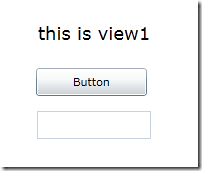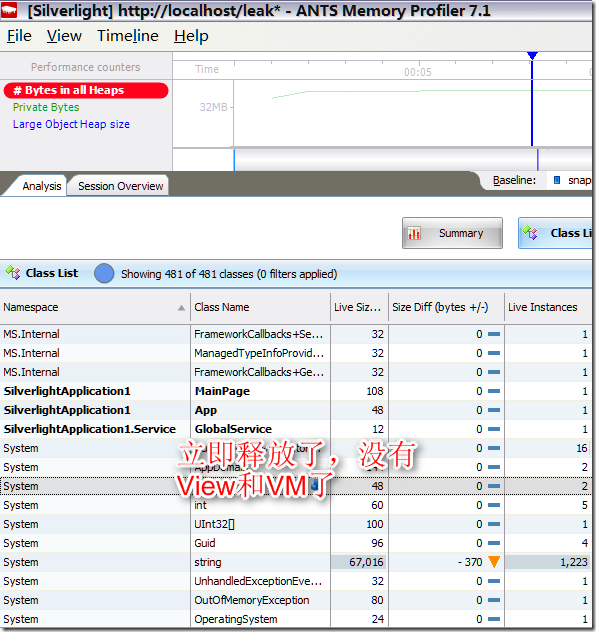由于MVVM是把View, ViewModel, Model紧紧绑定在一起的模式,特别视图和视图模型通过实现观察者模式双向绑定和NotifyPropertyChanged事件,似乎更加容易造成内存泄露/内存不释放。网上也有这种说法。真的是这样的吗?我们来实际测试一下。
实际测试MVVM是不是容易内存泄露
为了说明问题,我把MVVM搞复杂一点,在ViewModel里面引用一个Singleton单例模式的Service,这个Service定义如下:
1: namespace SilverlightApplication1.Service
2: { 3: public class GlobalService
4: { 5: private static readonly GlobalService Instance = new GlobalService();
6: 7: static GlobalService()
8: { 9: } 10: 11: public static GlobalService GetInstance()
12: { 13: return Instance;
14: } 15: } 16: } 写一个ViewModel,里面引用了Service,用到了ICommand,实现了INotifyPorpertyChanged接口:
1: using System.ComponentModel;
2: using System.Windows.Input;
3: using SilverlightApplication1.Service;
4: 5: namespace SilverlightApplication1.MVVM
6: { 7: public class ViewModel1 : INotifyPropertyChanged
8: { 9: private GlobalService _injectSingletonService;
10: 11: public ViewModel1(GlobalService injectSingletonService)
12: { 13: Property1 = "test1";
14: Command1 = new DelegateCommand(LoadMe, CanLoadMe);
15: 16: _injectSingletonService = injectSingletonService; 17: } 18: 19: private string _property1;
20: public string Property1
21: { 22: get { return _property1; }
23: set 24: { 25: _property1 = value;
26: 27: if (PropertyChanged != null)
28: { 29: PropertyChanged(this,
30: new PropertyChangedEventArgs("Property1"));
31: } 32: } 33: } 34: 35: public ICommand Command1 { get; set; }
36: public event PropertyChangedEventHandler PropertyChanged;
37: 38: private void LoadMe(object param)
39: { 40: 41: } 42: 43: private bool CanLoadMe(object param)
44: { 45: return true;
46: } 47: } 48: } 来一个视图View,绑定ViewModel,有个button绑定了ICommand,属性也绑定了。
1: <UserControl x:Class="SilverlightApplication1.MVVM.View1"
2: xmlns="http://schemas.microsoft.com/winfx/2006/xaml/presentation"
3: xmlns:x="http://schemas.microsoft.com/winfx/2006/xaml"
4: xmlns:d="http://schemas.microsoft.com/expression/blend/2008"
5: xmlns:mc="http://schemas.openxmlformats.org/markup-compatibility/2006"
6: mc:Ignorable="d"
7: d:DesignHeight="300" d:DesignWidth="400">
8: 9: <Grid x:Name="LayoutRoot" Background="White">
10: <TextBlock Height="65" HorizontalAlignment="Left" Margin="57,82,0,0" Name="textBlock1" Text="this is view1" VerticalAlignment="Top" Width="224" FontSize="18" />
11: <Button Content="Button" Command="{Binding Command1}" Height="28" HorizontalAlignment="Left" Margin="55,130,0,0" Name="button1" VerticalAlignment="Top" Width="111" />
12: <TextBlock Height="28" HorizontalAlignment="Left" Margin="56,173,0,0" Name="textBlock2" Text="{Binding Property1}" VerticalAlignment="Top" Width="114" />
13: </Grid>
14: </UserControl>
这个View1的界面是这样子的:

View1.xaml.cs代码:
1: using System.Windows.Controls;
2: using SilverlightApplication1.Service;
3: 4: namespace SilverlightApplication1.MVVM
5: { 6: public partial class View1 : UserControl
7: { 8: public View1()
9: { 10: InitializeComponent(); 11: 12: this.DataContext = new ViewModel1(GlobalService.GetInstance());
13: } 14: } 15: } 辅助类DelegateCommand源码:
1: using System;
2: using System.Windows.Input;
3: 4: namespace SilverlightApplication1
5: { 6: public class DelegateCommand : ICommand
7: { 8: public event EventHandler CanExecuteChanged;
9: 10: Func<object, bool> canExecute;
11: Action<object> executeAction;
12: bool canExecuteCache;
13: 14: public DelegateCommand(Action<object> executeAction,
15: Func<object, bool> canExecute)
16: { 17: this.executeAction = executeAction;
18: this.canExecute = canExecute;
19: } 20: 21: #region ICommand Members
22: 23: /// <summary>
24: 25: /// Defines the method that determines whether the command
26: 27: /// can execute in its current state.
28: 29: /// </summary>
30: 31: /// <param name="parameter">
32: 33: /// Data used by the command.
34: 35: /// If the command does not require data to be passed,
36: 37: /// this object can be set to null.
38: 39: /// </param>
40: 41: /// <returns>
42: 43: /// true if this command can be executed; otherwise, false.
44: 45: /// </returns>
46: 47: public bool CanExecute(object parameter)
48: { 49: 50: bool tempCanExecute = canExecute(parameter);
51: 52: 53: 54: if (canExecuteCache != tempCanExecute)
55: { 56: 57: canExecuteCache = tempCanExecute; 58: 59: if (CanExecuteChanged != null)
60: { 61: 62: CanExecuteChanged(this, new EventArgs());
63: 64: } 65: 66: } 67: 68: 69: 70: return canExecuteCache;
71: 72: } 73: 74: 75: 76: /// <summary>
77: 78: /// Defines the method to be called when the command is invoked.
79: 80: /// </summary>
81: 82: /// <param name="parameter">
83: 84: /// Data used by the command.
85: 86: /// If the command does not require data to be passed,
87: 88: /// this object can be set to null.
89: 90: /// </param>
91: 92: public void Execute(object parameter)
93: { 94: 95: executeAction(parameter); 96: 97: } 98: 99: #endregion
100: } 101: } MainPage的代码:
1: <UserControl x:Class="SilverlightApplication1.MainPage"
2: xmlns="http://schemas.microsoft.com/winfx/2006/xaml/presentation"
3: xmlns:x="http://schemas.microsoft.com/winfx/2006/xaml"
4: xmlns:d="http://schemas.microsoft.com/expression/blend/2008"
5: xmlns:mc="http://schemas.openxmlformats.org/markup-compatibility/2006"
6: mc:Ignorable="d"
7: d:DesignHeight="300" d:DesignWidth="400" xmlns:sdk="http://schemas.microsoft.com/winfx/2006/xaml/presentation/sdk">
8: 9: <Grid x:Name="LayoutRoot" Background="White">
10: <Button Content="Add view" Height="36" HorizontalAlignment="Left" Margin="20,31,0,0" Name="button1" VerticalAlignment="Top" Width="115" Click="button1_Click" />
11: <sdk:TabControl Height="197" HorizontalAlignment="Left" Margin="28,82,0,0" Name="tabControl1" VerticalAlignment="Top" Width="346">
12: <sdk:TabItem Header="tabItem1" Name="tabItem1">
13: <Grid />
14: </sdk:TabItem>
15: </sdk:TabControl>
16: <Button Content="Close view" Height="35" HorizontalAlignment="Left" Margin="148,32,0,0" Name="button2" VerticalAlignment="Top" Width="108" Click="button2_Click" />
17: </Grid>
18: </UserControl>
MainPage界面,主要是在Tab里面打开View1,不断打开关闭,打开关闭,因为View1是用MVVM模式实现的,看看有内存泄露:

MainPage.xaml.cs,就是测试代码,正常情况下点击关闭tab,可能GC不会立即回收内存,这里为了便于测试,手动加了GC.Collect。(正常情况下,不推荐使用GC.Collect())
1: using System;
2: using System.Windows;
3: using System.Windows.Controls;
4: using SilverlightApplication1.MVVM;
5: 6: namespace SilverlightApplication1
7: { 8: public partial class MainPage : UserControl
9: { 10: public MainPage()
11: { 12: InitializeComponent(); 13: } 14: 15: private void button1_Click(object sender, RoutedEventArgs e)
16: { 17: var v = new View1();
18: TabItem t = new TabItem {Content = v, Header = "header " + DateTime.Now.Second.ToString()};
19: this.tabControl1.Items.Add(t);
20: } 21: 22: private void button2_Click(object sender, RoutedEventArgs e)
23: { 24: this.tabControl1.Items.RemoveAt(0);//view1, viewModel1并没有立即释放,由GC决定何时决定。
25: 26: System.GC.Collect(); 27: System.GC.WaitForPendingFinalizers(); 28: 29: //{
30: // FooContext context = new FooContext();
31: // context.Load(context.MyQuery);
32: //}
33: } 34: } 35: }
测试结果:内存泄露和MVVM无关
我的测试结果是内存能够释放,没有内存泄露问题,也就是说MVVM模式和内存泄露无关。那种所谓的MVVM更容易内存泄露的说法没有什么道理。但不排除你的ViewModel和Model里面有复杂的引用关系,比如你的VIewModel或者Model引用了其他的类,你可能没有察觉,而那些类可能是Public Static的(是GC Root,不释放),或者是永远不释放的(如MainForm)引用,那就复杂了。由于你的ViewModel被那些不释放的对象引用着,而你却不知道,那就是内存泄露了。这和MVVM没有关系。

深入思考和继续阅读
通常.NET程序的内存泄露原因:
- Static references
- Event with missing unsubscription
- Static event with missing unsubscription
- Dispose method not invoked
- Incomplete Dispose method
有关如何避免.NET程序的内存泄露,请仔细阅读MSDN这两篇文章,详细讲述了<如何检测.NET程序内存泄露>以及<如何写高性能的托管程序>
- How to detect and avoid memory and resources leaks in .NET applications
- Writing High-Performance Managed Applications : A Primer
有关.NET的自动内存管理机制、GC机制,垃圾回收原理等深层次内容,请仔细阅读下面的内容:
- 买书《CLR Via C#(3rd Edition)》,里面有《Memory Management》这一章专门讲述了.NET CLR的自动内存管理和垃圾回收机制
- CodeProject上的文章《Memory Management Misconceptions》有助你深入理解Root, Generation 0, 1…
@:Mainz → http://www.cnblogs.com/Mainz
®: 博文是本人当时的学习笔记及知识整理,由于自身局限错误在所难免,敬请斧正. 博文中源码只作为例子学习参考之用,不保证能运行,对后果不负任何责且无任何质保,如有不明请给我留言
©: 本文版权属于博客园和本人,版权基于署名 2.5 中国大陆许可协议发布,欢迎转载,但未经作者同意必须保留此段声明,且在文章页面明显位置给出原文连接和署名Mainz(包含链接),不得删节,否则保留追究法律责任的权利。
)
)

)
![[Kaggle] Digit Recognizer 手写数字识别](http://pic.xiahunao.cn/[Kaggle] Digit Recognizer 手写数字识别)

、清洗drop()、合并concat()、重新建立索引reset_index() - (Python))
)


 所见的各种用法 - Python代码)




)
)
)
:预付款(prepayment)的标准处理流程)
,DataFrame写入 MySQL(create_engine)- Python代码)